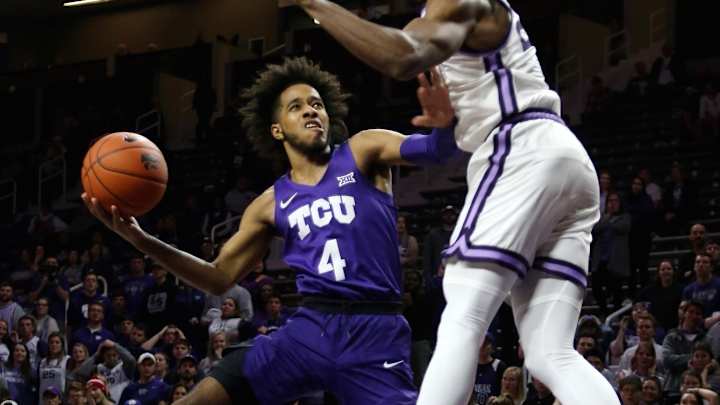Huskies Trade 6 Players for 6 New Ones — How Much Better Are They?

With so much wheeling and dealing, Mike Hopkins now knows what it feels like to be Jerry Dipoto, the Seattle Mariners' baseball general manager capable of pulling off deal after deal, in this case swapping six players for another six.
So what did the University of Washington basketball coach get for his trouble?
And what did he lose?
The Husky incoming: guards Terrell Brown (Arizona), Daejon Davis (Stanford) and P.J. Fuller (TCU), and forwards Emmitt Matthews (West Virginia), Samuel Ariyibi (NBA African Academy) and Langston Wilson (Georgia JC).
The dearly departed: guards Marcus Tsohonis (Virginia Commonwealth, RaeQuan Battle (Montana State), Erik Stevenson (South Carolina) and Nate Pryor (New Mexico State), and big men J'Raan Brooks (UC San Diego) and Hameir Wright (no new team).
While the pedigree looks good on those now joining the Husky roster, the numbers actually aren't all that dramatically different from those who fled the scene for new opportunities.
What's important to remember is there are 10 portal transfers involved in this collective Husky roster flip, which means no one was happy with or excelling in their roles whether in or out of Seattle, lest they wouldn't have gone school-shopping.
With just four of the UW newcomers competing as active Division 1 players last season, most comparisons will be done here with averages.
Don’t Turn ya back on Washington, Put Washington on your Back ... 💛💜💛💜💛💜 #HOMETEAM
— Will Conroy (@CHILLCONROY) May 18, 2021
Height-wise, those who exited took a collective 468 inches with them, compared to 466 for the newbies. That's roughly an average of 6-foot-6 per player all the way around. Slight advantage, old guys.
As for eligibility, the newcomers have a collective 14 seasons of college basketball eligibility remaining, compared to 13 left for the players who exited. Brown and Davis are good only for a season each. Five of the six who left have at least two or three seasons left to play. Slight advantage, new guys.
The four new players with D-1 experience averaged 7.8 points per game per man, scoring 694 points in 93 games; the UW defectors altogether averaged 7 points a game, scoring 835 points in 119 games. The UW basically traded one double-figure scorer (Tsohonis, 10.4) for another (Davis, 10.3), with everyone else in single digits. Slight advantage, new guys.
Experience-wise, the newcomers altogether started 60 of 93 D-1 games this past season; the departed Huskies opened 56 times in 129 outings. Advantage, new guys.
As far as shooters, the four new D-1 players hit 236 of 582 field-goal tries, for 40.5 percent; those who left the program were good on just 295 of 774 attempts, or 38.1 percent. Advantage, new guys.
From 3-point range, the four newcomers connected on 61 of 186 tries, or 32.7 percent; the former Huskies really struggled with just 109 makes in 368 attempts, or 29.6 percent. Advantage, new guys.
The four incoming players grabbed 297 rebounds, or collectively 3.1 per man per game; the ex-UW players, who were part of one of the nation's worst rebounding teams, snagged just 164, or 1.3 each person an outing. Big advantage, new guys.
The new additions handed out 197 assists, or 2.1 per game per man; the former UW players dished out 135, or 1.1 per game. Advantage, new guys.
As ball-handlers, the transfers joining the UW committed 136 turnovers, or 1.2 per game each player; the exiting hoopsters were guilty of 164 miscues, or 1.3 an outing. Slight advantage, new guys.
Finally, we come to the only stat that really matters: the win-loss record. The four D-1 newcomers had a combined 62-46 record at their old schools, a .574 winning percentage, which greatly puts to shame the UW's simply awful 5-21 record and .192 percentage. Big advantage, new guys.
Follow Dan Raley of Husky Maven on Twitter: @DanRaley1 and @HuskyMaven
Find Husky Maven on Facebook by searching: HuskyMaven/Sports Illustrated

Dan Raley has worked for the Seattle Post-Intelligencer, Atlanta Journal-Constitution and Fairbanks Daily News-Miner, as well as for MSN.com and Boeing, the latter as a global aerospace writer. His sportswriting career spans four decades and he's covered University of Washington football and basketball during much of that time. In a working capacity, he's been to the Super Bowl, the NBA Finals, the MLB playoffs, the Masters, the U.S. Open, the PGA Championship and countless Final Fours and bowl games.